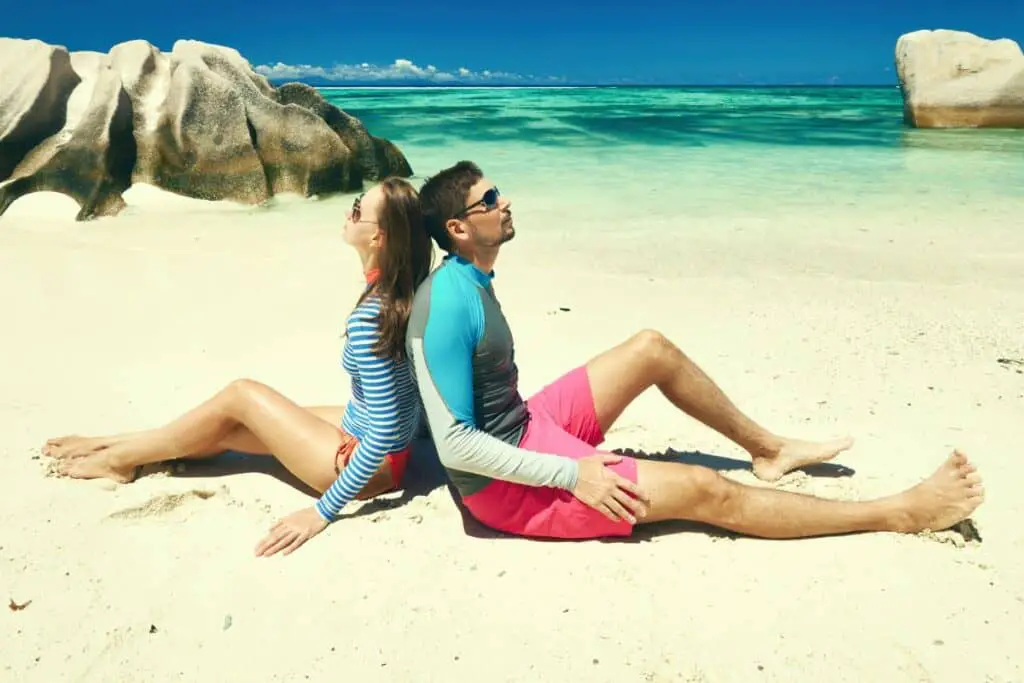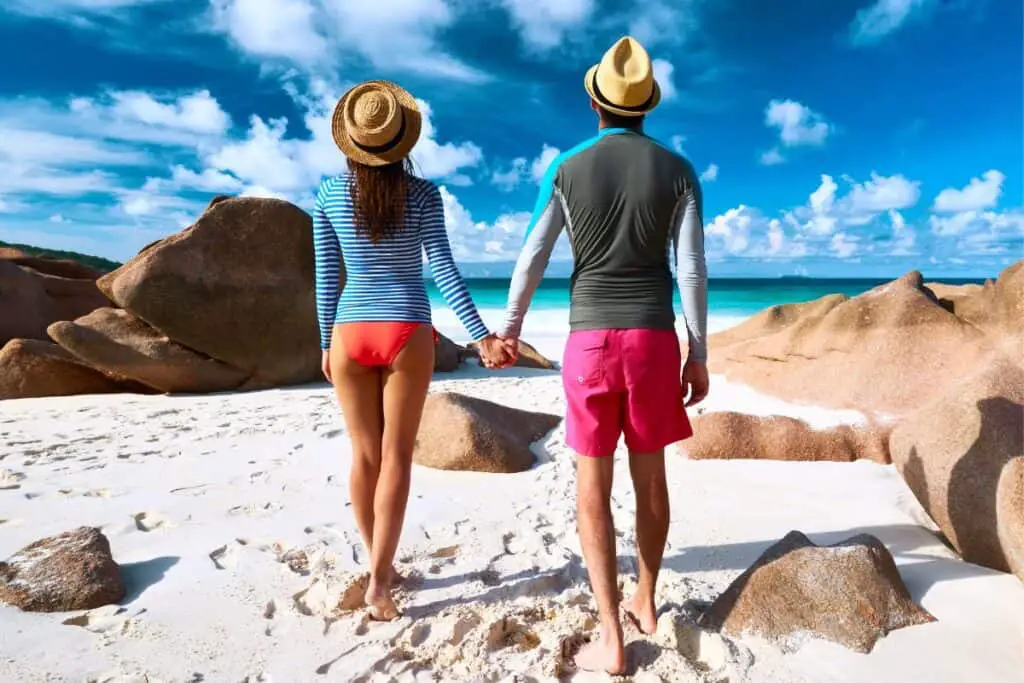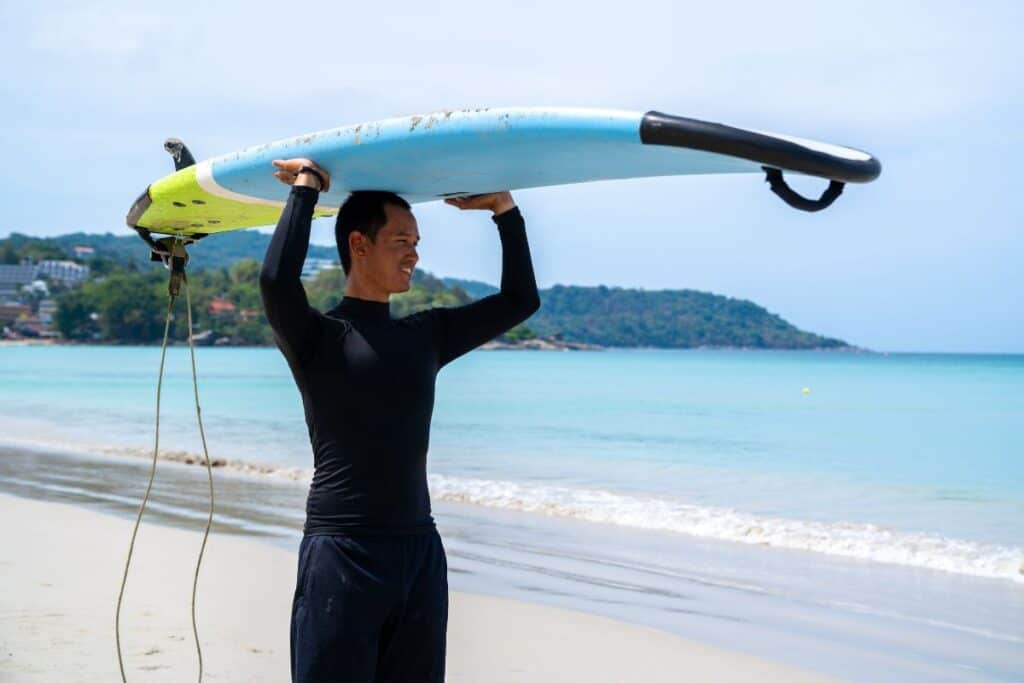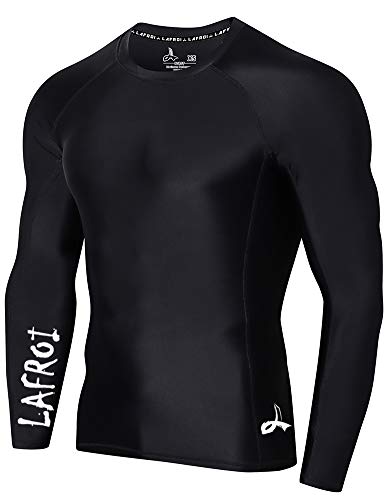A rashie, commonly referred to as a rash guard or rash vest, is a versatile piece of apparel designed primarily for aquatic activities.
Its primary function is to shield your skin from the abrasions that can occur with vigorous movement—whether you’re surfing, swimming, or engaging in other water sports.

The tight-fitting, stretchable fabric, such as spandex, nylon, or polyester, hugs your body contours to provide a comfortable layer between you and your aquatic environment.
The Benefits of Rash Guard
- Comfort – The comfort provided by a rashie extends to its ability to protect you from the sun’s harmful rays.
- Sun Protection – As an item of sun-protective clothing, it mitigates the risk of sunburn by blocking a portion of UV radiation, becoming an essential part of your sun safety strategy during extended periods outdoors.
- Weather protection – Available in various sleeve lengths and thicknesses, rash guards cater to different weather conditions and temperature levels, effectively serving your needs throughout the seasons.
- Quick-drying – The quick-drying characteristics of the materials used in rashies also contribute to their practicality. When you exit the water, you can rely on your rash guard to dry rapidly, preventing the discomfort of wearing soggy clothing and ensuring ongoing comfort as you engage in your day’s activities.
With a rashie as part of your water-sport attire, you’re investing in both protection and comfort, ensuring a safer and more enjoyable experience in and around the water.
Design and Materials
When selecting a rashie, you are choosing a garment that combines advanced fabrics and design features focused on protection from the sun and surf-related abrasions.
The materials and construction play pivotal roles in ensuring durability, comfort, and safety.
Read next – Best Women’s Rash Guard Guide
Fabric and Composition
Rash guards are primarily made from a blend of nylon, polyester, and spandex.
This combination provides a lightweight and stretchy fabric that can enhance your comfort in the water.
- Nylon/Polyester: Durable, quick-drying, and holds color well.
- Spandex (Lycra): Adds stretch to ensure the fabric moves with you.
This fabric blend often includes moisture-wicking properties, which help draw sweat away from the skin, and a quick-dry capability for post-swim convenience.
Construction and Features

Seams and stitching are crucial in a rashie’s construction.
Flatlock stitching is commonly used to minimize chafing and maximize comfort.
- Seams: Designed to prevent abrasion and enhance movement.
- Thumb holes and compression elements: Found in some designs for added functionality.
Features such as four-way stretch material ensure complete freedom of movement, critical for performance in watersports.
Protection and Comfort
Rash guards provide protection from UV rays with a UPF rating indicating the level of sun protection.
- Many rashies offer a UPF rating of 50+, which means they block 98% of UVA and UVB rays.
Designed to prevent sunburn, chafing, and skin abrasions, rashies remain comfortable even in prolonged use due to their snug yet unrestrictive fit.
Style and Fit
You’ll find rashies in a range of styles, from short-sleeved to long-sleeved, with options for male, female, and unisex designs.
- Colors: Available in a broad palette, from vibrant hues to sleek blacks.
- Fit: Typically a tight fit to prevent drag in water; however, looser styles are available.
Environmental Considerations
Some rashies are made from recycled materials, aligning with ecologically sustainable practices.
- Brands like Body Glove, Quiksilver, and Rip Curl often feature eco-friendly options in their ranges.
Choosing a rash guard made with these materials can help reduce your environmental impact.
Sizing and Fit
A proper fit is crucial for a rash guard’s effectiveness.
- Tight fit: Ensures the garment stays in place and reduces drag.
- Stretchy fabric: Accommodates different body types and sizes.
Accurate sizing will enhance overall protection and prevent restrictions in your movement.
Brand and Quality
A reputable brand can be a good indicator of quality.
Look for trusted names such as Body Glove, Quiksilver, or Rip Curl when considering a purchase.
- Price points vary, from affordable, budget-friendly options to higher-end garments.
- Investment in quality can result in better durability and protective features.
Choose a brand and quality that stand for durability and have positive user feedback.
Activities and Uses
Rash guards, also known as rashies, are versatile garments initially designed for surfers to prevent chafing and rashes caused by the surfboard.
They now serve multiple functions, from sun protection to enhancing safety during various activities.
Water Sports
In the realm of water sports, rash guards are a staple.
Their snug fit and smooth material make them ideal for activities like:
- Surfing: Protects against board rash.
- Scuba Diving and Snorkeling: Worn under wetsuits for extra warmth or alone for sun protection.
- Wakeboarding and Windsurfing: Reduces the impact of falls and slides against the water.
- Kitesurfing and Stand Up Paddle Surfing: Shields the skin from the sun and chafing.
- Freediving and Swimming: Provides a streamlined fit, reducing drag.
Sun Protection and Safety
Rash guards often come with UPF 50 rating, meaning they block out 98% of the sun’s UV radiation, offering an excellent alternative to sunscreen which can wash off in water.
They’re a smart choice when spending long hours under direct sunlight, as they help reduce your risk of skin cancer. Consider them your shade in the water.
Versatility
A rash guard is not just a piece of swimwear. It can be worn at the beach or pool, doubling as casual wear or an extra layer under clothing.
Many rashies are stylish enough to transition from water activities to beachside lounging without the need for a change.
Additional Sport Uses
Beyond traditional beach and water sports, these swim shirts find their use in sports like Canoe Polo and Paddling, where they protect against splashes and the sun.
BJJ (Brazilian Jiu-Jitsu) practitioners wear rash guards known as gis to prevent mat burns and facilitate ease of movement during grappling.
Whether paired with swim trunks or over swimsuits, rash guards elevate your comfort and protection across diverse activities.
Care and Maintenance
Taking proper care of your rashie ensures its durability and maintains its protective features, such as UV resistance and ability to prevent rashes from abrasion.
Cleaning and Storage
To clean your rashie, it’s recommended to rinse it in cold water after each use, especially if it has been exposed to chlorine or saltwater.
This helps in removing any residual chlorine, salt, sand, and other particles that can degrade the fabric over time. For washing, use a mild detergent and opt for hand washing or a gentle machine wash cycle.
Storing your rashie is just as important. Make sure it is completely dry before storing to prevent mildew growth. Keep it flat or hang it away from direct sunlight to avoid deterioration of the fabric.
Durability

Rashies are typically made from a blend of nylon and polyester, which are known for their longevity and chlorine resistance.
This fabric choice not only lends comfort while wearing but also ensures that the garment can withstand the rigors of frequent use in water environments, be it the ocean where sand and abrasion are common, or chlorinated swimming pools.
To keep the fabric in good condition, avoid rough surfaces that can cause pilling or snagging. Remember, rashies are more delicate than typical t-shirts and require a bit more attention to maintain their condition.
Lifecycle and Replacement
Your rashie won’t last forever, but with proper care, you can maximize its lifecycle.
Regular inspection for signs of wear, such as thinning fabric or loss of elasticity, can indicate when it’s time for a replacement. Also, if the rashie no longer offers the same level of comfort or protection from the sun, it’s time to consider getting a new one.
Typically, rashies can last for a good number of seasons, but this heavily depends on usage and adherence to care instructions.
If you frequently partake in water activities, it may be prudent to replace your rashie more regularly to ensure continuous sun protective clothing performance.
6 Things Surfers Need to Know When Choosing the Rashie
When selecting a rashie, your focus should be on protection, comfort, and style, along with considering where to purchase and the price range to ensure you get the best value for your investment.
1. Material & Protection
Your rashie should offer UV protection to shield you from the sun’s harmful rays. Look for an Ultraviolet Protection Factor (UPF) of 50+ which blocks out most UV radiation.
One of the biggest things people look for when buying any article of clothing is comfortable, and a rash guard shouldn’t be any different. You’re not going to want to wear it if it isn’t comfortable. This is where the right material comes into play.
Rash guards are made from a blend of synthetic materials, each providing its own unique levels of comfort, protection, breathability, and warmth.
- Nylon-Spandex: The most common material used in rash guards, nylon-spandex will provide a form fit, excellent breathability, and it will be quick to dry while remaining stretchy and comfortable.
- Lycra: With even more stretch than nylon-spandex, lycra won’t restrict movement. Plus, it is highly breathable and quick to dry.
- Polyester: Polyester is another material that is highly breathable. It is also moisture-wicking, meaning it will disperse sweat and keep you cool even on the hottest day. What polyester does lack is the stretchability than other materials offer, possibly restricting movement.
- Neoprene: Neoprene provides insulation against cold water. While it may not be right for all-around use, a neoprene rash guard can work as a stand-alone, or provide an extra layer of warmth in colder water. er.
Pro tip – Choose a stretch fabric that offers a snug fit without restricting movement. Rash guards made of quality fabrics reduce drag in the water and may function as a buoyancy aid to a minor extent.
2. Fit & Comfort
Second to the material when it comes to comfort is fit.
While you can find rash guards that fit either snug or loose, the snug ones will result in less rubbing and chafing as they move with your body and have less excess material getting in the way. Less excess material also provides less resistance in the water, making paddling that much easier.
Comfort is paramount, so opt for a rashie that allows good movement and doesn’t chafe. It should sit close to the skin but not too tight.
3. Stitching
Stitching is something that easily gets overlooked until after the rash guard is purchased and worn. The wrong stitching on a tight-fitting piece of clothing can be more uncomfortable than many people realize.
High-quality rash guards will use a stitching process called flat locking to produce an almost seamless feel and reduce the chances of any rubbing and chafing from the garment itself.
4. Dry Time
Keeping yourself comfortable and warm while on the water is key to enjoying the time spent there, but what about when it’s time to take a break?
Remaining wet on a hot summer day may not be too big of a deal, but on those days when it’s cooler, staying wet can quickly reduce your body temperature and, in turn, make you uncomfortably cold and reluctant to get back into the water.
Try and find a rash guard that is both moisture-wicking to remove excess sweat and will dry quickly so that your body can better regulate temperature.
5. Style
Rashies come in various styles, with options like long sleeves for more protection or short sleeves to keep you cooler. Select one based on the activities you’ll be undertaking.
- Long Sleeve: Long-sleeve rash guards can provide protection not for just those colder days on the water, but also for those days when the sun is beating down on you and you want the best protection from its harmful rays. The right long-sleeve rash guard can be perfect for just about any type of surf session.
- ShortSleeve: Short-sleeve rash guards will typically offer a better range of motion than their long sleeve-counterparts – depending on the material they are made from -whilesacrificing some of the protection offered with longer sleeves. A short-sleeve rash guard can be great for hotter days or can be easily worn under a wet suit for an added layer of warmth.
- Tank: Tanks are the perfect rash guards for those days when overheating might be a problem. While they offer less protection from the sun, they will keep you cooler than styles with long sleeves.
6. Extra Features
When buying a rash guard, you’re going to want to get the best possible protection you can for your money.
While you may have to spend a little extra, some rash guards will come with features like added UV protection or high-collared neck guards that protect one of the most vulnerable areas on your body from getting sunburnt.










